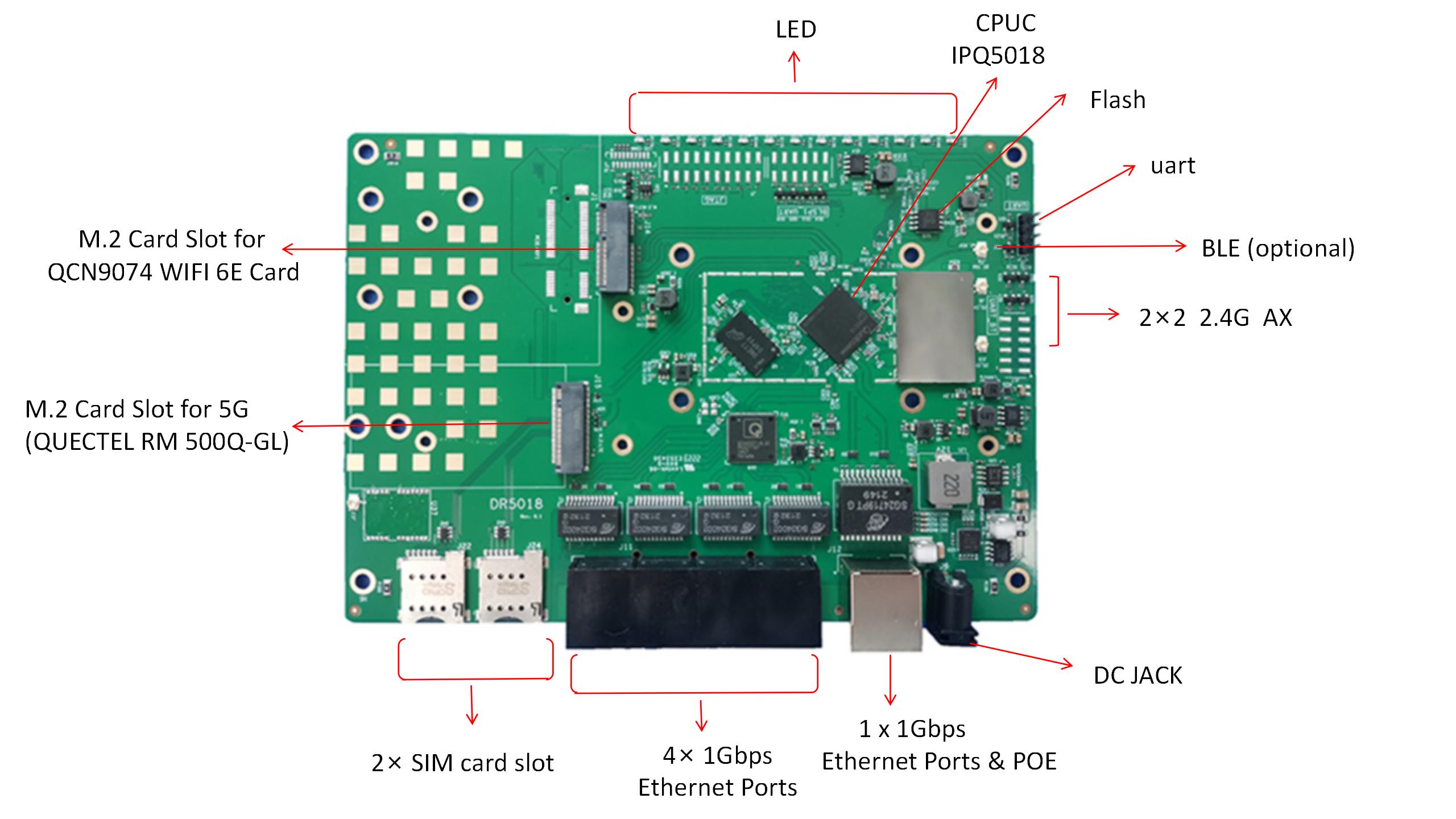wallys//Routerboard/DR5018-wifi6-IPQ5018-2T2R-2.5G-ETH-port-802.11AX-MU-MIMO-OFDMA-supporting-QCN9074-wifi-card
Routerboard/DR5018-wifi6-Qualcomm-IPQ5018-2T2R-2.5G-ETH-port-802.11AX-MU-MIMO-OFDMA-supporting-QCN9074-wifi-card.html
Dual-core ARM 64bit A53@1.0GHz Processor
512MB DDRL3L System Memory
4MB NOR Flash, 128MB NAND Flash
2x2 On-board 2.4GHz radio,up to 573Mbps physical Data Rate
Support BT5.1
M.2 Card Slot for 5G (QUECTEL RM 500Q-GL) ;
M.2 Card Slot for QCN9074 WIFI 6E Card
Wallys Communications (Suzhou) Co LTD develops, designs and manufactures wireless communication products, including routers, network cards, AP and antennas. Customization is also supported, We have 90% of the world market, We're a supplier to Facebook. welcome to consult.
EMAIL:sales@wallystech.com
WEB:https://www.wallystech.com/
| Absolute Maximum Rating |
Parameter | Rating | Unit |
Supply Voltage | 12 | V |
Operating Temperature Range | -40 to +70 | ºC |
Storage Temperature Range | -45 to +105 | ºC |
Operating Humidity Range | 5 to +95 (non-condensing) | % |
| Hardware Specifications |
Symbol | Parameter |
CPU | Qualcomm-Atheros IPQ5018 |
CPU Frequency | Dual-core ARM 64 bit A53 @1.0 GHz processor |
System Memory | 512MB DDR3L 16-bit interface with 32-bit memory bus design |
Ethernet Port | 4 x 1Gbps Ethernet Ports or 1 x 1Gbps Ethernet Port & Poe |
NGFF Slot | M.2 Card Slot for 5G (QUECTEL RM 500Q-GL) ;M.2 Card Slot for QCN9074 WIFI 6E Card |
EMMC | 4G/8G(optional) |
USB /header | 1x USB 3.0 Port |
POE | NA |
DC Jack | 12V power supply |
LED header | LED for power ,Wifi strength |
Serial Port | support |
Wireless | On-board 2x22.4GHz MU-MIMO OFDMA 802.11b/802.11g/802.11n/802.11ax,max 23dBm per chain 2x IPEX Connectors |
| Bluetooth | BT5.1 |
Nor Flash | 8MB |
Nand Flash | 128 MB |
DDR | 512MB |
Dimension | 170mm x 120mm x 15mm |
| Radio TX Specifications(2412MHz-2482MHz) |
Operating Mode | Data Rate | Power | Tolerance | |
1 Chain | 2 Chains | |||
2.4Ghz 802.11ax HE20 | MCS0 | 23dbm | 26dbm | ±2dB |
MCS1 | 23dBm | 26dBm | ±2dB | |
MCS2 | 23dBm | 26dBm | ±2dB | |
MCS3 | 23dBm | 26dBm | ±2dB | |
MCS4 | 23dBm | 26dBm | ±2dB | |
MCS5 | 23dBm | 26dBm | ±2dB | |
MCS6 | 23dBm | 26dBm | ±2dB | |
MCS7 | 22dBm | 25dBm | ±2dB | |
MCS8 | 21dBm | 24dBm | ±2dB | |
MCS9 | 21dBm | 24dBm | ±2dB | |
MCS10 | 18dBm | 21dBm | ±2dB | |
MCS11 | 17dbm | 20dbm | ±2dB | |
2.4Ghz 802.11ax HE40 | MCS0 | 23dbm | 26dbm | ±2dB |
MCS1 | 23dBm | 26dBm | ±2dB | |
MCS2 | 23dBm | 26dBm | ±2dB | |
MCS3 | 23dBm | 26dBm | ±2dB | |
MCS4 | 23dBm | 26dBm | ±2dB | |
MCS5 | 23dBm | 26dBm | ±2dB | |
MCS6 | 23dBm | 26dBm | ±2dB | |
MCS7 | 22dBm | 25dBm | ±2dB | |
MCS8 | 21dBm | 24dBm | ±2dB | |
MCS9 | 21dBm | 24dBm | ±2dB | |
MCS10 | 21dBm | 24dBm | ±2dB | |
MCS11 | 19dbm | 22dbm | ±2dB | |

Comments
Post a Comment